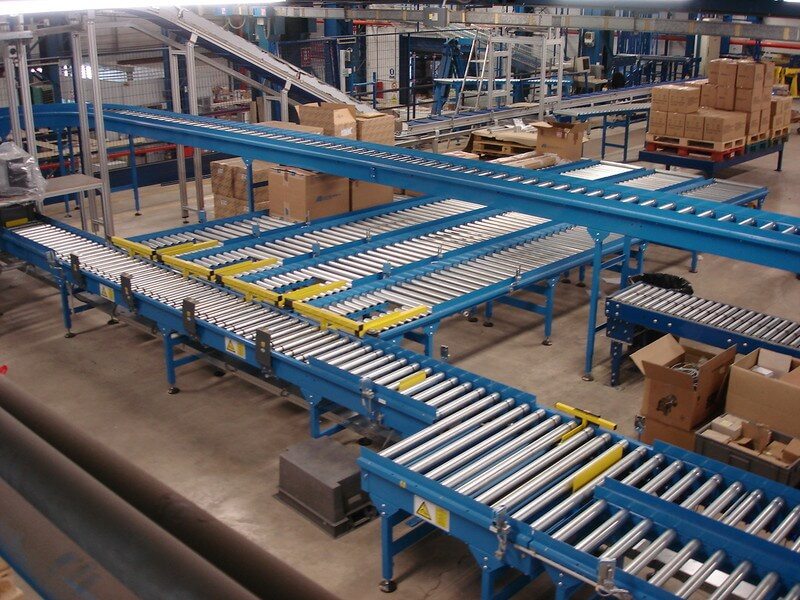Conveyor Systems & Equipment
Conveyor systems have revolutionized various industries by streamlining the movement of goods and materials within a facility. These systems provide a reliable and efficient method of transporting items from one location to another, reducing manual labor and optimizing workflow. In this article, we will explore the different types of conveyor systems, their benefits, applications, factors to consider when choosing them, installation and maintenance processes, and future trends in this evolving industry.
Introduction
Conveyor systems are mechanical devices designed to move goods and materials from one point to another. They consist of various components such as belts, rollers, chains, and motors, working together to facilitate the smooth and controlled transportation of items. These systems are widely used in industries such as manufacturing, warehousing, food processing, mining, and many others. By automating the movement of goods, conveyor systems increase efficiency, reduce operational costs, and improve workplace safety.
What are Conveyor Systems?
Conveyor systems are a network of interconnected mechanical components that work together to transport goods and materials within a facility. The basic components of a conveyor system include a load-bearing surface, such as a belt or roller, which carries the items, and a motor that drives the movement. Additional elements such as pulleys, idlers, and control systems help regulate the speed, direction, and flow of the transported items.
Types of Conveyor Systems
Belt Conveyors
One of the most common types of conveyor systems is the belt conveyor. These systems use a wide belt made of various materials, such as rubber or fabric, to transport items. Belt conveyors are versatile and can handle a wide range of products, from small parts to heavy bulk materials. They are commonly used in industries like manufacturing, mining, and agriculture.
Roller Conveyors
Roller conveyors utilize a series of rollers to move items along a predetermined path. These systems are often used in assembly lines and warehouses to facilitate the movement of packages or containers. Roller conveyors are known for their durability and can handle heavy loads. They are also customizable to suit different sizes and shapes of items.
Chain Conveyors
Chain conveyors use chains and sprockets to transport items along the conveyor surface. These systems are ideal for handling heavy loads or items with irregular shapes. Chain conveyors are commonly found in industries like automotive manufacturing and scrap metal recycling.
Screw Conveyors
Screw conveyors consist of a rotating helical screw inside a tube, which moves materials along the conveyor. These systems are suitable for transporting bulk materials, such as grain, powders, and granules. Screw conveyors are widely used in industries like agriculture, food processing, and wastewater treatment.
Pneumatic Conveyors
Pneumatic conveyors use air pressure to transport materials through a pipeline. They are often used for transferring powders, granules, or small particles over long distances. Pneumatic conveyors are efficient, flexible, and can be easily integrated into existing systems.
Bucket Conveyors
Bucket conveyors utilize buckets attached to a belt or chain to transport bulk materials vertically or horizontally. These systems are commonly used for handling materials in the mining, construction, and agriculture industries. Bucket conveyors are suitable for transporting large quantities of materials efficiently.
Benefits of Conveyor Systems
Conveyor systems offer numerous benefits to industries that rely on efficient material handling. Some of the key advantages include:
Increased Efficiency
By automating the transportation process, conveyor systems eliminate the need for manual labor, reducing human error and increasing overall productivity. They can handle large volumes of items at a consistent speed, enabling faster processing times and smoother workflow.
Cost Savings
Implementing conveyor systems can lead to significant cost savings for businesses. By reducing manual labor requirements, companies can allocate resources to other areas of their operations. Conveyor systems also minimize product damage and loss during transport, resulting in fewer financial losses.
Enhanced Safety
Conveyor systems contribute to a safer working environment by reducing the need for manual lifting, carrying, and pushing of heavy items. They are equipped with safety features such as emergency stop buttons and guarding systems to prevent accidents and injuries.
Versatility
Conveyor systems are highly versatile and can be customized to suit specific material handling needs. They can be designed to accommodate different sizes, shapes, and weights of items. With various types of conveyors available, businesses can choose the most suitable system for their unique requirements.
Common Applications of Conveyor Systems
Conveyor systems are utilized in a wide range of industries and applications. Some common areas where conveyor systems play a crucial role include:
Manufacturing Industry
In manufacturing plants, conveyor systems streamline the movement of raw materials, components, and finished products between different stages of the production process. They ensure a smooth workflow, reduce manual handling, and increase production efficiency.
Warehousing and Distribution Centers
Conveyor systems are essential in warehouses and distribution centers for sorting, routing, and moving packages or products. They enable efficient order fulfillment, inventory management, and reduce the time and effort required for manual handling.
Food Processing
Conveyor systems are widely used in the food processing industry to transport raw materials, ingredients, and finished food products. They ensure hygienic handling, prevent contamination, and maintain product quality during various stages of processing and packaging.
Mining and Construction
In the mining and construction sectors, conveyor systems are employed for transporting bulk materials such as ores, aggregates, and construction materials. They enable efficient material extraction, processing, and transportation, improving overall operational efficiency.
Airport Baggage Handling
Conveyor systems play a vital role in airport baggage handling systems. They transport luggage from check-in counters to the appropriate departure gates and vice versa, ensuring timely delivery and minimizing the chances of lost or mishandled baggage.
Factors to Consider when Choosing Conveyor Systems
When selecting a conveyor system for a specific application, several factors need to be considered:
Material Handling Requirements
Understanding the nature of the materials to be transported is crucial in determining the appropriate conveyor system. Factors such as size, weight, fragility, and flow characteristics of the items should be taken into account.
Conveyor Length and Width
The length and width of the conveyor system depend on the layout and space available within the facility. It is important to ensure that the chosen system fits seamlessly into the existing infrastructure without hindering other operations.
Speed and Capacity
The required speed and capacity of the conveyor system should align with the production or transportation needs of the facility. Choosing a system with the appropriate specifications ensures optimal performance and prevents bottlenecks.
Power Source
Conveyor systems can be powered by electricity, hydraulics, or pneumatics. The availability of power sources and the energy efficiency of the system should be considered to minimize operational costs and environmental impact.
Maintenance and Serviceability
Regular maintenance is essential to keep conveyor systems operating smoothly. Choosing a system that is easy to maintain and service can help prevent downtime and reduce overall maintenance costs.
Installation and Maintenance of Conveyor Systems
Proper installation and maintenance are crucial for the efficient and safe operation of conveyor systems. The following steps are involved in the process:
Planning and Designing
Before installation, a thorough assessment of the facility and material handling requirements is conducted. This includes determining the layout, conveyor route, support structures, and any necessary modifications to the facility.
Installation Process
Once the design is finalized, the installation process begins. It involves assembling the conveyor components, mounting the system, aligning the belts or rollers, and connecting the necessary electrical or pneumatic connections. Safety features and control systems are also installed and tested.
Regular Maintenance and Inspection
To ensure optimal performance and longevity, regular maintenance and inspection of conveyor systems are essential. This includes checking for wear and tear, cleaning the components, lubricating moving parts, and replacing any damaged or worn-out parts. Regular inspections help identify potential issues before they escalate into major problems.
Future Trends in Conveyor Systems
As technology continues to advance, conveyor systems are also evolving to meet the changing needs of industries. Some future trends in conveyor systems include:
Automation and Robotics Integration
Conveyor systems are increasingly being integrated with automation and robotics technologies. This enables seamless material handling, sorting, and packaging processes, further improving efficiency and reducing reliance on manual labor.
IoT and Data Analytics
The integration of the Internet of Things (IoT) technology allows conveyor systems to collect and analyze data in real time. This data can be used to optimize performance, monitor equipment health, predict maintenance needs, and improve overall operational efficiency.
Energy Efficiency
Conveyor systems are becoming more energy-efficient through the use of advanced motor technologies, smart control systems, and energy recovery mechanisms. Energy-efficient systems help reduce operational costs and minimize environmental impact.
Conclusion
Conveyor systems have become an integral part of various industries, facilitating the efficient movement of goods and materials. They offer numerous benefits such as increased efficiency, cost savings, enhanced safety, and versatility. With different types of conveyor systems available, businesses can choose the most suitable option for their specific needs. Proper installation, regular maintenance, and staying abreast of future trends in the industry are crucial for maximizing the benefits of conveyor systems and ensuring long-term success.
FAQs For Conveyor Systems & Equipment
What is the maximum weight capacity of a conveyor system?
The weight capacity of a conveyor system depends on the specific type and design of the system. Some conveyor systems can handle light loads of a few kilograms, while others are designed to transport heavy loads exceeding several tons. It is essential to consider the weight capacity requirements when selecting a conveyor system.
Can conveyor systems be customized to fit specific needs?
Yes, conveyor systems can be customized to fit specific material handling needs. They can be tailored to accommodate different sizes, shapes, and weights of items, as well as specific layout and space requirements. Customization ensures that the conveyor system seamlessly integrates into the existing infrastructure and optimizes operational efficiency.
Are conveyor systems suitable for transporting delicate items?
Yes, conveyor systems can be designed to transport delicate or fragile items safely. By incorporating features such as cushioning, adjustable speed controls, and gentle handling mechanisms, conveyor systems can ensure the smooth and damage-free transportation of delicate items.
How do conveyor systems improve workplace safety?
Conveyor systems improve workplace safety by reducing the need for manual lifting, carrying, and pushing of heavy items, which can lead to musculoskeletal injuries. They also come equipped with safety features such as emergency stop buttons, guarding systems, and sensors to prevent accidents and injuries caused by contact with moving parts.
Are conveyor systems suitable for outdoor use?
Yes, conveyor systems can be designed for outdoor use. Outdoor conveyor systems are constructed with materials that can withstand various weather conditions, such as corrosion-resistant metals or durable plastics. They are also equipped with weatherproofing measures and additional safety features to ensure safe and reliable operation in outdoor environments.
Contact Us For Free Quote
Email: sales@magnatechengg.com
Tel: +97143404243
Mobile: +971 50 633 8365



[…] In this article, we will explore the fundamental principles of material handling, the types of equipment used, and best practices implemented by Magnatech Electromechanical […]
[…] Monitoring and Control Systems […]